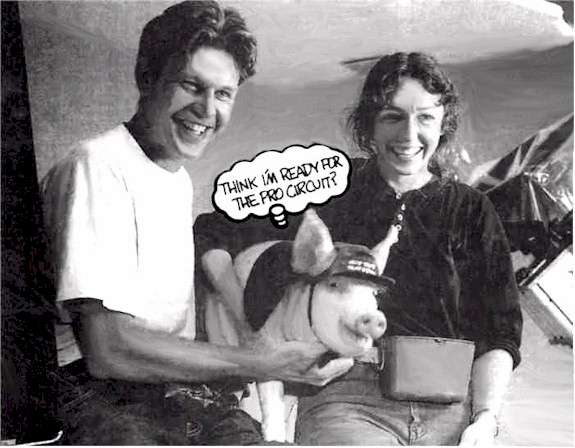Upwardly Mobile Pigs May Get a Sty in the Sky
by Nina Rappaport
How can you produce disease-free
pigs in adequate numbers in a country the size of the Netherlands, which
produces 16.5 million tons of pork a year? MVRDV, an eight-year-old, Rotterdam-based
architectural firm, thinks it has the answer: Pig City, 40 pig farms stacked
one on top of the other in high-rise structures. It is presenting its
idea in the form of an exhibition, "KM3/Pig City," on view at
the Stroom Center for the Visual Arts.

The firm's name is an acronym formed from the initials of its principals: Winy Maas (M), Jacob van Rijs (VR) and Nathalie de
Vries (DV). With a staff of 30, they design not only the usual houses, apartments and office buildings but visionary schemes in the mould of earlier architects'
utopias - Frank Lloyd Wright's 1958 Broadacre City or Le Corbusier's 1935 Ville Radieuse. Their vision stems from an innate Dutch desire to accumulate more usable land
for their small country. So just as the Dutch have reclaimed land from the sea for agricultural development horizontally, now they are finding a way to build
vertically.
The goal here is not to prettify the landscape but to serve economic, demographic and environmental needs.
The problem that Pig City addresses
is the clash between urbanisation and farming. Not only is the Netherlands
becoming denser than planners originally calculated, with urban development
spreading into the country's "Green Heart," but the pig crisis
is rapaciously invading the agricultural landscape. MVRDV calculated that
to raise pigs organically and without diseases, each pig would need 1,726
square metres of land - 1,062 square metres more than is allotted now.
Unfortunately, that would leave only 774 square metres per person, or
roughly 25% of the country. Since denying people either land or meat was
out of the question, MVRDV asked how pig production could continue in
a limited space. The only answer was "up."
|
As depicted
in the video in the exhibition, Pig City is a comprehensive solution to
this problem. It envisions no fewer than 40 farms stacked in 87-by-87-metre
towers rising more than 500 metres high. Instead of jostling about in
a truck over long distances to market and slaughter, the pigs are transported
via elevators to a slaughterhouse on the ground floor, preventing disease
from spreading. Pigs would be organically fed with grain grown on the
property around the towers, on organic garbage and high-protein Tilapia
fish - which in turn feed on the pigs' manure, achieving a closed feeding
system between pigs and fish. In Pig City, rainwater would be collected
in basins through a reed field around the tower, and hay would be grown
in a 7.5 metre diameter around the tower and then hung in rolls, like
toilet paper, from the 10-metre-high ceilings to supply the pigs' bedding.For
additional pig pleasure, apple trees would be planted in the towers. Air
would be filtered through water stored in rooftop tanks. The pigs' manure
would produce methane gas, which, after being stored for the required
year in a rooftop storage dome, would supply electricity to both the tower
and to 2,250 housing units nearby. And then, you might ask, would the
pigs have enough room to waddle around? MVRDV has thought of that, too.
The towers would provide 640-square-metre balconies cantilevered from
the building exterior, planted with oak trees complete with the prerequisite'
truffles at their base. MVRDV calculated that 76 towers would be needed
to satisfy the current demand for pig products - 32 for the urban areas
in the Netherlands and 44 clustered near harbours for export.
Pig City may not be as far-fetched as it seems at first glance. Vertical factories are being built for manufacturing around
the world, and agriculturists are intrigued. MVRDV has commissions for vertical hydroponic greenhouses mixed with housing and offices in Bovenkerkerpolder and a
vertical fish farm in Tokyo. It could be the beginning of a new era. As land-use specialist Henk van Oosten of the agricultural think-tank Innovation Network says,
"A collaboration could link together the agricultural world with city builders."
Ms Rappaport is an architectural
critic based in New York. She is working on a book on factory design.

Very Important Pig

Pig
wranglers James Delaney and Breta Jarden prepare to put the SunSmart pig
through its paces
|
 Animals
Animals Animation
Animation Art of Playing Cards
Art of Playing Cards Drugs
Drugs Education
Education Environment
Environment Flying
Flying History
History Humour
Humour Immigration
Immigration Info/Tech
Info/Tech Intellectual/Entertaining
Intellectual/Entertaining Lifestyles
Lifestyles Men
Men Money/Politics/Law
Money/Politics/Law New Jersey
New Jersey Odds and Oddities
Odds and Oddities Older & Under
Older & Under Photography
Photography Prisons
Prisons Relationships
Relationships Science
Science Social/Cultural
Social/Cultural Terrorism
Terrorism Wellington
Wellington Working
Working Zero Return Investment
Zero Return Investment

